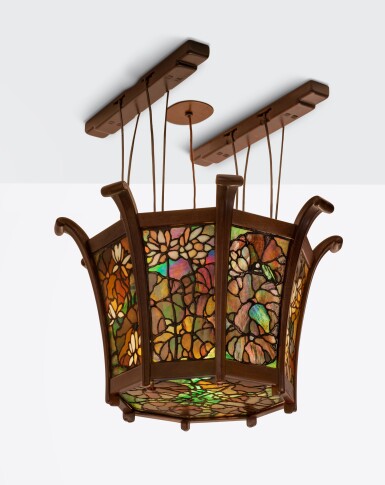Important Design
Important Design

Greene & Greene
An Important and Rare "Lotus" Lantern from the Living Room of the Robert R. Blacker House, Pasadena, California
Auction Closed
June 7, 06:14 PM GMT
Estimate
300,000 - 400,000 USD
Lot Details
Description
Greene & Greene
An Important and Rare "Lotus" Lantern from the Living Room of the Robert R. Blacker House, Pasadena, California
circa 1908
with the original mahogany ceiling supports, brass ceiling plate, and silvered and painted glass diffuser
leaded glass panels executed by the Sturdy Lange Company, Los Angeles, California
mahogany frames executed in the workshop of Peter Hall, Pasadena, California
leaded opalescent, cathedral and iridized cathedral glass (selectively plated), mahogany, ebony, patinated brass
28¼ in. (71.8 cm) drop
16¼ in. (41.3 cm) height of shade
25½ in. (64.8 cm) diameter of shade
Mr. and Mrs. Clarence Otto Bockelman, by acquisition of the house and contents, late 1940s
Max and Marjorie Hill, by acquisition of the house and contents, circa 1950
Private Collection
Cathers & Dembrosky, New York
Acquired from the above by the present owner, 1996
Wendy Kaplan, The Art that is Life: The Arts & Crafts Movement in America, 1875-1920, Boston, 1987, p. 403
Sheila Schwartz, ed., From Architecture to Object: Masterworks of the American Arts & Crafts Movement, New York, 1989, pp. 18 and 114-115
Randell L. Makinson, Greene & Greene: The Passion and the Legacy, Salt Lake City, 1998, pp. 100-101 (for the above mentioned period photographs)
Randell L. Makinson, Thomas A. Heinz and Brad Pitt, Greene & Greene: The Blacker House, Layton, UT, 2000, pp. vii, 48 (for a period photograph of the model in situ), 65, 76 (for the above mentioned period photograph,) 77 (for a drawing of the model) and 79 (for a period photograph of the model in situ)
Edward R. Bosley, Greene & Greene, London, 2000, p. 4 (for the model in situ)
Wendy Kaplan, The Arts & Crafts Movement in Europe & America: Design for the Modern World, New York, 2004, p. 268
Marvin Rand, Greene & Greene, Layton, UT, 2005, p. 190
Edward R. Bosley and Anne E. Mallek, eds., A New and Native Beauty: The Art and Craft of Greene & Greene, London, 2008, pp. 12, 55, 175-176, 239 (for a period photograph of the model in situ) and 264
Judith A. Barter, Apostles of Beauty: Arts and Crafts from Britain to Chicago, New Haven, CT, 2009, p. 112 (for a period photograph of the model in situ)
David Cathers, Arts and Crafts Lighting from the Collection of the Two Red Roses Foundation, Palm Harbor, FL, 2017, pp. 22, 93 (for the above mentioned period photograph), 94 and 97
The frames were fabricated by Peter Hall. The stained glass was made by the studio of Sturdy Lange in Los Angeles. This firm was a partnership between Harry Sturdy (dates unknown), an artist and decorator from Chicago, and Emil Lange (1866-1934), a businessman from Davenport, Iowa. The partnership lasted only about five years, between 1906 and 1910, during which time they created the finest of Greene & Greene's stained glass. The lanterns are similar in materials and construction to other stained glass Sturdy Lange produced for the Greenes, including the celebrated front door, windows, and light fixtures of the David B. Gamble house (Pasadena, 1907-1909). The glass, in warm tones of brown, moss, amber, ecru, and white, is heavily iridized on the surface to reflect a rainbow of colors when the lanterns are not lit. This glass, similar to that used by Frank Lloyd Wright for his windows in the Susan Lawrence Dana house (Springfield, Illinois, 1902-1904), was made by American glassmakers in Brooklyn, West Virginia, or Indiana. Like the lampshades of Tiffany Studios, the pieces of glass are assembled with copper foil to form a strong, rigid panel. The foil was trimmed and modeled into an uneven, thick-and-thin line that is also textured with ridges and mounds, lending shape and organic form to the flowers and leaves. Borrowing another technique from Tiffany Studios (and others), pieces of glass are layered here and there, so that the center of a lily pad or the petal of a flower projects from the surface of the panel, adding additional dimensionality.
The six lanterns illuminated the living room in two rows of three. The Greenes designed five side panels and three bottom panels. The side panels were organized into three arrangements that utilized four of the designs, repeating them twice in the same order: 1-2-3-4-1-2-3-4, 4-2-3-5-4-2-3-5, and 5-2-1-4-5-2-1-4. Each arrangement was used for two lanterns. Each lantern in the pair has a different bottom panel, ensuring that no two lanterns are identical. The pairs of lanterns were placed diagonally from one another. This complicated arrangement provides both diversity and continuity, and illustrates the architects' passion for detail. Based on these patterns and historic images, the present lot likely hung over the piano near the entrance to the room. The Blacker lanterns, like the front doors of the Blacker and Gamble houses, are some of Greene & Greene's finest stained-glass work.
- Julie Sloan
You May Also Like










